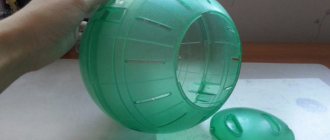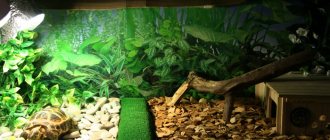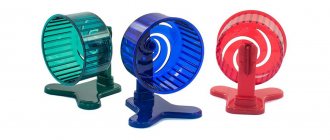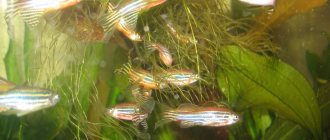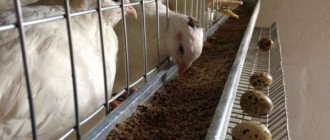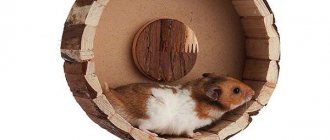Don't want to buy a drinking bowl at the store or do you just like to make things? One way or another, we will try to help you and tell you how to make a drinking bowl for a hamster with your own hands at home. There is nothing complicated about it; the device can be made within five minutes. The main thing is to have the right materials in your home.
Making a flat drinker
You can make the polika yourself
How can you make a hamster's drinking bowl more convenient and accessible for your pet? The best option would be a flat drinker. If you want a flatter drinker with an interesting design, you can use the method for which we will need:
- plastic bottle;
- scissors or knife;
- felt-tip pen;
- ruler;
- tube (if you have two or more hamsters, then there should be 2-3 tubes);
- nail.
Let's take a bottle of any liquid with a volume of 0.5 liters. Be sure to wash it thoroughly. Turn it over vertically and mark it in the shape of a rectangle: approximate dimensions 2cm in height and 7cm in length. Using a knife or scissors, cut a hole according to the diagram; we will need it to pour liquid into the bottle. We make holes on the side using a nail, use the following method: we clamp the nail with pliers and heat it over an open fire; at home, you can use a gas burner as a heating element. So, when the nail is hot, we make the required number of holes in our bottle blank.
Next, take the tubes, pre-cut to the size you need. In the container they should be 1 cm high, and outside 3 cm. The main thing is to ensure that the tubes are at the same distance from each other and at the same height from the bottom of the cell. Animals should be able to reach the product with ease.
Now let's start the installation - there is nothing complicated here. Your homemade water container is attached to the bottom of the cage using wire. You just need to tie the opposite sides of the product to the bottom of the cage one by one. Everything is ready, now fill the container with water through the rectangular cutout at the top.
Some tips for using a drinking bowl
Hamsters are quite nimble animals; they can easily throw off a sippy cup or chew off its plastic spout. And if securely fixing the drinking bowl helps solve the first problem, then you will not be able to cope with the hamster’s natural desire to chew everything. In this case, you should try to purchase a drinking bowl with a metal spout for your pet in the near future.
What other difficulties may be associated with a sippy cup? And how to solve them? Here are some tips that will come in handy:
- homemade sippy cups leak and wet the litter, so you can put a saucer under the spout;
- you must be sure that the water supply is normal and the hamster is drinking. This is very simple to do: every day, apply a line on the surface of the bottle with a marker to mark the water level (the marker is easily erased with alcohol). If the water level does not decrease, then either the drinking bowl is broken or the hamster is sick;
- If there is algae inside the bottle, it must be cleaned with soda and a toothbrush.
Sometimes the hamster simply does not know how to use the water bowl. In this case, he will have to be taught to drink from a spout.
Finally, we note that homemade sippy cups for hamsters are not as reliable as store-bought ones. But for some time they can be replaced. It is important to ensure that the hamster does not chew on the plastic spout, and that the structure itself does not leak.
Types of drinking bowls
There are many types of drinking bowls for small pets, in particular rodents. You can make almost all of them yourself. To do this, you will need a limited set of materials and tools, as well as basic carpentry and repair skills.
Drinkers come in a variety of types, to suit every color and taste.
Homemade drinking bowls differ from each other in design, volume, installation method and other important parameters. Some of them may be temporary, others are established for a long period. Classic options for providing a fun hamster with accessible water supplies are:
What are they?
Drinkers that are used for hamsters at home can be internal or external. They differ in the method of attachment, that is, they can be located inside or outside the cage. In the second case, it turns out to save space inside the pet’s habitat, this is especially true when the home is not too large.
There are many factors to consider when selecting. This is primarily size, convenience, reliability, and method of fastening.
You should also pay attention to stability, safety for the pet, as well as the aesthetic appearance of the structure.
You can also classify devices by design type. They can be suspended or floor-mounted.
As for floor options, they are placed inside the cage. The bowl should have enough weight so that a mobile pet cannot turn it over.
However, it is necessary to take into account the following: since water is in the public domain, it becomes contaminated quite quickly, and it is still possible to accidentally knock it over.
Hanging structures can be secured inside or outside the cage. The container can be open, but closed options are still the most popular. There are vacuum designs that include a container standing on a wide tray with high sides, from which water flows. Not everyone likes this option, since the liquid gets dirty quite quickly and you need to wash the entire device to clean it. Since such drinkers are most often made of soft materials (like plastic), hamsters often chew them.
Nipple drinkers for pets include a flask from which water flows through a tube ending with a locking mechanism. The hamster gets liquid by pressing its tongue on the latch, and the animal will have to get used to this. There are also ball mechanisms that operate in a similar way to the previous one.
Such options are used especially often, because the water remains clean and does not spill throughout the cage.
Some owners choose bottle drinkers with a reservoir. Water slowly flows out of the container into a small depression. These drinkers are most often used by bird owners, but hamsters can also use them. However, with this choice, you need to take into account that the water will also be open and the structure will have to be washed and cleaned frequently.
Step-by-step instruction
Now let's look at how to make a drinking bowl for a hamster with your own hands of one type or another.
- Nipple drinkers
Perhaps the best option, which is highly recommended if you want to make it for your pet yourself. You will need a small plastic bottle - half-liter or liter, a body from a regular ballpoint pen, a ball from a bicycle bearing, a weak spring from a fountain pen and a thin stick (even a lollipop will do).
Here's what you'll need to do:
- Place the ball from the bearing into the handle body. Measure the place where it is stuck, and this must be done so that the ball protrudes a little, literally a millimeter, above this mark;
- then remove the ball and saw off part of the body along the mark using a hacksaw;
- put the ball back, then connect the spring with the lollipop stick and also install it inside the prepared body;
- fix the stick on the reverse side so that it, together with the spring, acts as a stop;
- then make a hole in the bottle and insert the manufactured structure;
- Seal the joint thoroughly to prevent water leakage.
You can make a drinking bowl yourself
It is better to use sealant as a waterproofing agent. The glue takes a long time to dry, and besides, it is very toxic, especially for the weak body of a hamster.
- Drinking bowl from a plastic bottle
A very simple and popular solution. This option is perfect for a large and friendly hamster family or for large hamsters that consume a lot of water. Ideally, it is best to take a 0.5 liter bottle.
The process of making such a drinking bowl is extremely simple. You will need to unscrew the cap and make a small hole in the center. It can be drilled or pierced with a hammer and nail, but it is better to heat the nail and melt the hole.
To make a drinking bowl from a plastic bottle, you must follow the instructions
After this, insert a regular cocktail tube into the resulting hole. It is advisable that its diameter be larger than the diameter of the hole - this will help avoid water leakage and the need to solve this problem. If, however, the straw turns out to be smaller than the hole, you will have to seal it using the same sealant or glue.
The straw must be inserted so that the end with the corrugated element is on the outside.
- Drinking bowl from a cut bottle
The manufacturing technology of such a drinking bowl is similar to the method described above.
But there is one important difference - you will first need to cut the plastic bottle into two parts. Its lower part will not be needed in the future.
You can cut the bottle with a stationery knife - this is the best option, and this task is performed very easily. If this tool is not at hand, you can take scissors or a regular kitchen knife, but it is recommended to warm them up first - this will allow you to cut the plastic more evenly and quickly.
The main advantage of a drinker made from a cut bottle over a design made from an uncut bottle is that you don’t need to disassemble anything to replenish water supplies - just top it up. But you need to remember that it is strongly recommended for any breed of hamster to change the water at least once every two days. So in any case, you will have to remove the homemade drinking bowl to change the water.
- Floor drinking bowls
Here you don’t need to have any skills at all, since such a drinking bowl for a hamster can be made very quickly with your own hands. But such designs also have a number of disadvantages. First of all, it is very easy to knock them over; therefore, all the water will fall on the litter, which will have to be taken out and dried for a long time. It should also be noted that the water will quickly become polluted. It will have to be changed at least once a day - and this is not always convenient for the person himself.
This drinking bowl for a hamster is very simple, but not very convenient.
How to avoid this? First, you need to make higher sides so that water does not overflow over them. But the height must be optimal so that the rodent can reach the water without climbing into the drinking bowl. One or two centimeters will be enough. Secondly, attach the container to some heavy object, for example, a wooden block - the hamster will not be able to knock it over.
How to make a water bowl for a hamster with your own hands - video
Assembly from a baby bottle
You will need a lid for the container and a small piece of hose. Take the lid and punch a hole in it. Insert the hose. Fill the bottle with water and screw on the cap. The main thing is to make sure that the liquid does not drip in a vertical position.
Making a flat drinker
This sippy cup is equipped with one or more straws, depending on the number of pets living in one cage. Manufacturing stages:
- make markings in the shape of a rectangle. The bottle must be in a horizontal position;
- cut out the excess part;
- make holes on the side;
- insert the tubes into the holes so that the bend and corrugation are on the outside.
The sippy cup is ready. All that remains is to fill the container with water through the rectangular top and secure it to the cage.
How to install (attach) a water bowl for a hamster in a cage?
Double-sided hooks, office clips, and stands made of a thick plastic cup will help secure the water container. It is important to make sure that the drinking bowl is securely hung or installed, and that the straw is easy for the hamster to reach.
Assembly from a plastic bottle
To make a water bowl for a hamster with your own hands, you will need the following materials:
- 05 liter plastic bottle, preferably water bottle;
- self-tapping screw or nail;
- roulette;
- felt-tip pen;
- corrugated tube;
- wire.
To begin with, let's take a plastic bottle and prepare it for use by washing it and cleaning it from any remaining lemonade and labels. Take a self-tapping screw and screw it into the plug. We need a hole slightly smaller in diameter than the size of the tube that we must insert into the cork.
The tube needs to be divided in half, leaving the corrugated part. Insert into the cork so that the height of the tube in the bottle is 2cm, and outside 5cm. To prevent liquid from leaking out when tilting the bottle, the hole made with a self-tapping screw must be smaller than the diameter of the tube. Water flows from the bottle only if the straw is installed incorrectly. To fix the damage, you just need to take another cap and make a new hole in it.
Now we need to use a tape measure and a felt-tip pen to draw a scale on our homemade drinking bowl. Thanks to the markings, you can track the amount of liquid your pet drinks. After the work is finished, you need to attach the bottle with liquid to the cage using wire. We fix the product at a height of 4-5 cm so that the rodent can easily drink water.
So we learned how to make a drinking bowl for a hamster with our own hands. Such a product cannot break: all that needs to be repaired is to change the drinking tube when your pet chews it.
Let's move on to choosing a drinking bowl for a rodent
If you have several hamsters, you should decide on the required volume of the drinking bowl. If your pet is alone, then the smallest sippy cup will do. When there are several of them, it is better to choose the medium size. It is recommended to ask the seller to fill the container with water and wipe it. In this way, it is possible to determine the presence of leaks and the unimpeded supply of water.
Pet stores are filled with drinking bowls of various colors, so you can find a product that matches the color of your pet’s cage. Of course, this does not matter to the animal; the main thing is the presence of clean water in the drinking bowl.
How to install (attach) a drinking bowl for a hamster
Let's look at the five simplest and most accessible ways to attach a drinking bowl.
Did you know? Hamsters are distinguished by good intelligence - they remember their nickname, distinguish between relatives and can learn to perform several tricks.
- If you have a drinking bowl with a hole in the lid for fastening, then just make a double-sided hook from a piece of wire. On one side we make a larger loop for attaching to the edge of a cage or container, and on the other side we attach a drinking bowl to a small loop.
- If the drinking bowl comes with a mount for the cage, then a large office clip will help to attach it to the container. We take out one wire and make a loop of the same shape, but larger, from a long piece of wire. We hook the drinking bowl mount to the loop we made. We attach the clamp to the edge of the container. We insert a new wire into the clamp along with the drinking bowl.
- We make a stand for the automatic drinker from a large, thick plastic cup. The diameter of the bottom of the cup should be slightly larger than the diameter of the automatic drinker. Turn the glass over and place the drinking bowl in the center. Mark the outline of the hole for the automatic drinker at the bottom of the cup with a marker and cut it along the marked line. On the side of the cup we mark and make a hole for the straw at the desired height. We insert the automatic drinker into the made stand and place it in the container.
- You will need a plastic bottle with a slightly larger diameter than the drinking bowl. Cut off the bottom of the bottle and part of the side so that it can be installed in the bottle. We make a small hole on the edge of the bottle for attaching the wire and a small hole in the bottom for the tube. We place the drinking bowl in the bottle and attach it to a wire hook, hanging it in the container.
- We make a stand from a toilet paper or paper towel roll. Using a marker, mark the contours on the side of the sleeve and mark the hole for attaching the wire, and cut it out. To place the drinker, cut a small semicircle at the bottom of the sleeve for the spout of the drinker. We insert the drinker into the stand, thread the wire through the hole and hang it over the edge of the container.
Making simple tunnels
A hamster cage must contain at least one small tunnel. And for games outside the home, complex structures of medium and large size are suitable. You can make a permanent entertainment room for your furry friend or build the attraction anew each time, changing its size and direction of moves.
Children are showing great interest in creating entertainment for hamsters. We invite you to study the instructions for creating simple tunnels that even a schoolchild will understand.
Paper tube for cage
The simplest option is to use a cardboard paper towel tube as a building material. You can put it in the cage unchanged or make windows in the tube so that the animal can come out through them.
The sleeve tube can also be installed in external cardboard labyrinths.
Game room
Do your kids love to play with and watch hamsters? Then give them an idea: make a tunnel for a hamster from an unnecessary cardboard box. The kids will happily get down to business, use their creative imagination and create an attraction with love.
There are a lot of construction options. We will tell you how to make a hamster maze in two different ways.
- The first method does not involve the use of glue. Take a box and pieces of cardboard: 3 strips should correspond in size to the length of the room, 5 to the width. On long pieces, make 5 cuts at equal distances from each other, and cut short pieces three times. Between the cuts, cut out doors, windows and holes for pipes. Now we can assemble our room. Install long partitions with the cuts up, and insert short parts into them with the cut down. You will get a lattice. If you have pipes planned, insert them into the round cutouts. Place the grid in the box and you can start playing right away!
- The second method is based on gluing the walls. It is good because you can create a variety of branches, as well as a rest room for a small creature. To glue the walls, use regular or construction tape.
Labyrinth from a construction set
Preschoolers and schoolchildren love to build various castles and fortresses from construction sets. Invite them to make an attraction for a hamster - they will happily complete this task. Moreover, children themselves know how to make a labyrinth for a hamster from Lego constructors interesting and convenient.
If you are building a walker for a dzhungarik, small parts are better suited. For the larger Syrian breed, use medium sized pieces. Using a small construction set inside the maze, you can build a small obstacle course for the animal, at the end of which you can place a tasty nut.
Book fortress
Old hardcover books are suitable for creating a large, spacious tunnel. To do this, they need to be placed with their roots facing up. It is better to completely enclose the space with books so that the hamsters do not run away in different directions. For one animal, the width of the passage can be 5-8 cm (so that the animal can easily turn around in it), but if you have several fluffies, the tunnels should be more spacious.
In such a book fortress, kids really love to have hamster races. Rodents are placed in a common closed room, after which they open the “door” and watch which of the animals gets to the exit first
At the same time, it is important to ensure that race participants do not violate the rules. If a cunning hamster climbs over the wall, he must be brought back
A maze made from books can also be used to train animals. To do this, you need to place small pieces of tasty food along the chosen path, and repeat the operation several times with the same route. Then you should place the treat only at the exit. You will be surprised how quickly your smart hamster will find it!
Tunnel made of plumbing parts
If your apartment has recently been renovated and you still have unnecessary parts for connecting pipes, use them to create a branched labyrinth! This attraction is suitable for both small Djungarian and larger Syrian and Caucasian hamsters. By the way, the tunnel made from plumbing looks very original. Another advantage is the collapsible design of the attraction, which means you can periodically change the direction of the moves.
Making it is very simple: connect the parts in any direction. It will be more interesting for the hamster to play if there are several exits in the pipe. But in this case, do not leave the home unattended, otherwise you will have to look for it throughout the apartment!
How to teach a hamster to drink on its own
If you choose a rodent not from a pet store, but pick it up from friends or acquaintances, it may be too small. The baby will require special care, because the animal can die of thirst. In this case, the responsibility falls on your shoulders to teach him to drink. It is permissible to feed tiny fluffies from a pipette or syringe without a needle, but this option should not take root for long. It is best to train your furry animal to drink on its own, so you can avoid unnecessary problems.
It is not difficult to teach a hamster to drink from a sippy cup, even if he sees it for the first time.
- The animal needs to explore the bottle on its own. Let him examine it carefully.
- Touch the bowl ball with your finger and lubricate the rodent's nose with a drop of water.
- Now touch his nose to the ball.
- These steps must be repeated until the furry animal begins to drink on its own.
From now on, you know exactly what you need to pay attention to when buying a drinking bowl, and you will definitely be able to teach your hamster to drink from it. Good luck finding the best sippy cup for your pet!
How often to refresh the water
The water in the drinking bowl is changed daily
It doesn’t matter whether the hamster managed to drink all the water or not. Otherwise, you risk exposing your pet to illness.
In summer, water should be changed two or three times a day, in winter and autumn at least once a day. It is important to raise the issue of water regime for newborn babies.
They are not yet able to reach the automatic drinker, so the best option would be a small saucer. The water in it needs to be changed every 3-4 hours. In order for your pet to be healthy and happy, he needs good care. Providing clean, fresh water is one way to take care of your pet. You can buy or you can build a simple drinking bowl yourself.
Where should the cage be?
Hamsters are naturally nocturnal and sedentary during the day. During the day they spend all their time indoors, sleeping or just lying down. Therefore, it is best to place the cage in a quiet room that is not frequently visited during the day. It should be ventilated, but without drafts. Hamsters are afraid of drafts and can easily catch a cold. It is not recommended to choose places in direct sunlight and near heating devices.
Place the cage in a bright, warm place where the temperature does not drop below 18-20 degrees. Despite the fact that hamsters are heat-loving animals, you should not tire them out in the heat. Find a place that is inaccessible to other pets. The cat or dog will disturb the rodent and make it nervous and restless.
Varieties
All toys that are chosen for pet rodents are aimed at two tasks:
- search for treats;
- encouragement to move and be active.
In some products, these two purposes can be successfully combined. It is worth noting that the treat for the hamster is safely hidden. To get to a tasty treat, you need to go through a maze or cope with a tricky structure. The smell of food is an additional incentive to go through the maze or perform other actions.
Other products that do not hide food are considered exercise equipment. The most common toy of this type is the running wheel.
Why does a ferret need a hammock?
Beginning ferret breeders are often surprised to learn that their pet needs a hammock, and not an ordinary bed, for a comfortable existence and sweet sleep.
Animals can sleep in boxes, on pillows, in their house, and even crawling into a warm sock or felt boot, but only a hammock allows a ferret to feel completely safe. This is due to the fact that wild relatives of domesticated ferrets always choose secluded dark places to sleep - under a stump, in dense bushes, or dig holes. Soft earth or grass perfectly takes the shape of the animal’s body, and it feels protected both from enemies and from bad weather.
Domestic ferrets living in an apartment do not have the opportunity to dig a hole for themselves, and the presence of a sleeping place, the same as dry leaves or grass, makes the pet happy - he sleeps well, so he plays and “hunts” with great pleasure.
What should be in a Syrian hamster's cage?
Syrian hamsters are twice the size of Djungarian hamsters. They lead a more sedate lifestyle and do not run long distance races. They make contact with people much better and are not afraid of them. This is why experts recommend purchasing small cages for Syrians, but be sure to equip them with a running wheel. Dimensions of 30x30 cm or 40x40 cm will be the best option for them.
When setting up a cage, you should give preference to a house of a size where all entrances and exits, as well as windows, will be wide enough so that the hamster can easily cross them.
Syrian hamster cage
When choosing sports equipment for a Syrian, you should make sure that the running wheel is the right size for him. The fact is that these fluffies grow larger than their fellow tribesmen, so a standard wheel may not suit them. The preferred wheel diameter for this breed is at least 20 cm.
DIY drinking bowl for a chinchilla, hamster or rat: what you need
You won't need to make any additional purchases. The necessary materials and tools are available in every home:
- hammer;
- a thick nail and a couple of screws;
- half-liter plastic bottle, vitamin bottle or other small container;
- several plastic covers;
- knife, preferably a stationery knife;
- rope or wire for fastening;
- cocktail straw with a bend;
- automatic writing pen;
- wooden block.
“Arm yourself” with the listed elements - and you can start.
How to teach a hamster to drink from a water bowl
It is recommended to install a drinking bowl in advance when preparing a home for a hamster, then the hamster, while exploring the new house, will be able to independently learn to drink water from the device. If you purchased a drinking bowl later, it is important to teach the animal to drink from it.
Not all hamsters know how to use new accessories, but that's okay, they will learn quickly. You can bring the animal up and carefully poke its nose into the drinking tube. But it’s best to use a little trick - smear the tip of the tube with juicy and aromatic food, a pear, an apple or a cucumber. The smell will attract the hamster, instinct will work, and he will learn to drink.
Floor accessory
These drinkers are installed on the bottom of the cage and are extremely easy to make yourself. You will need:
- any container with high sides;
- wooden block;
- Super glue.
The manufacturing algorithm is extremely simple. You need to glue the container to a wooden block. If you want, you can glue two containers at once, one for food and the other for water.
Important. Clean your pet's cage in a timely manner, keep the drinking bowl and food container clean.
Alternative to a sippy cup
If it is not possible to satisfy the animal’s needs (moving, the sippy cup is not ready, etc.), then how can you feed a hamster without a drinking bowl? Water can be replaced with succulent food, vegetables and fruits that contain a lot of moisture . Cucumbers, which are very loved by hamsters, cope well with this task.
Should you give hamsters apples?
The drinking bowl must first of all satisfy the rodent's need for fresh drinking water, and its aesthetic function is a secondary matter. The main thing is to regularly maintain cleanliness and ensure that the drinking bowl is full .
Actions to take if your pet is in an unnatural condition
Sometimes hamster owners notice strange behavior in their pets. These include frequent and heavy drinking, refusal of food and water, and other symptoms. If there is no improvement in the animal’s condition within two days, you should consult a veterinarian.
Doesn't drink or eat
In severe illnesses, the rodent refuses to eat and drink, which leads to exhaustion and dehydration. To avoid this, it is important for the hamster owner to know what to do if the animal does not drink water from the drinking bowl and does not eat. In this situation, you often have to force-feed your pet using a pipette or an insulin syringe without a needle. It is necessary to pour water into the animal’s mouth in small portions that the rodent can easily and quickly swallow. You can't put your hamster on its back.
Drinks a lot
The reason for increased thirst is the lack of succulent food in the animal’s diet. It is worth reviewing your pet’s diet and including more fresh fruits and vegetables. If after this the situation has not changed and the animal still drinks a lot, this is a sign of illness. One such disease is diabetes, which is common in dwarf hamsters.
The automatic drinking bowl will help the animal quench its thirst without difficulty. It is worth spending a few days teaching your hamster to drink from a water bowl. There is no need to worry if your rodent doesn't drink enough. A good appetite and active pet will make it clear that there is no reason to worry.
Why doesn't the animal drink water?
The reasons why a hamster refuses to drink water from a drinking bowl can be varied. If the animal has recently appeared in the family, its stressful state cannot be ruled out. In this case, there is no need to rush things - let him get comfortable and get used to the new living conditions.
Another factor is the inability to use the drinking bowl. We have already discussed above what to do in this situation.
We must not forget that hamsters are nocturnal animals. This means that the peak of their activity may occur at a time when household members are already sleeping. Accordingly, the animal quite possibly uses the drinking bowl, it just does it when no one is looking.
And finally, you need to take into account that the animal needs fresh water, which is recommended to be changed daily. The hamster will not drink stagnant water. It is also necessary to occasionally check how well the drinking bowl is functioning and whether there are any technical faults.
It should also be noted that newborn animals need, just like adults, to receive fresh water.
In this case, it is best to rinse the saucer several times a day and renew the liquid.
How healthy a pet will grow up depends entirely on its owners.
Therefore, having decided to take such an important step as getting a pet, you need to give it maximum attention and provide competent care. Only in this case will the hamster be active, friendly, develop properly and delight its owners
See below for a video review of drinking bowls for rodents.
How to make your own hammock
You can make a hanging bed for your pet yourself in literally a couple of hours, if you know how to sew, weave or knit at least a little.
From felt boots
The easiest option to make with your own hands is a hammock made from felt boots. It is enough to sew ties, straps, chains or carabiners to the felt boots (they can be cut from a worn-out backpack or old bag) so that the boot after hanging remains in a horizontal position, and the toe “looks” up. If desired, several small pockets can be sewn to the outside of the boot in which the ferret will hide his finds.
From a piece of fabric
Another simple option is a hammock made from a piece of fabric made by yourself. To make it you will need dense, soft and preferably natural fabric, it can be drape, denim, cashmere, thin felt, thick linen, etc.
You can also use fleece or faux fur, it is important that the material does not emit a strong odor, otherwise the animal will not use the hammock
The scrap of fabric for the base of the hammock is folded right sides inward and sewn on three sides (by hand or on a sewing machine). Next, the workpiece is turned inside out and the hole is sutured, tucking the cuts inward.
The blanks for the ties are folded in half lengthwise, right sides inward, and stitched with a 0.5 cm indentation from the cuts along the long side. The blanks are turned inside out, helping yourself with a pencil, short sections are tucked inside and sewn up. The finished ties are firmly sewn to the corners of the hammock base.
Tip: if you don’t want to bother with ties, you can use ready-made straps, chains, carabiners or dense cords such as paracord instead.
Hammock pillow
A hammock-pillow is made in almost the same way as a fabric hammock, only you need to take slightly larger scraps of fabric as a basis (at least a square with a side of 35 cm), and after turning the main part of the hammock inside, put foam rubber, rustling balls, or loosely stuff the workpiece with padding polyester, and only then sew up the fourth side. A hanging bed can be supplemented with a secret pocket by sewing another piece of fabric the size of the base to the pillow. In this case, the pet will be happy to “dive” inside this pocket and hide its “prey” in it.
Hammock tube
It’s easy to make a hammock-pipe with your own hands. Two rectangular pieces of fabric measuring approximately 40x60 cm and a piece of thin foam rubber or dense padding polyester slightly smaller than the fabric pieces are folded into a “sandwich”: the first piece of fabric is face down (on the table), a pad is placed on it, and the second piece of fabric is placed on top with the wrong side to the gasket. The “sandwich” is fastened with pins and stitched around the perimeter, tucking the sections of tissue flaps inside. If desired, quilt the entire surface of the workpiece. Next, the workpiece is rolled into a pipe along the long side, and the edges of the pipe are overlapped. Then sew ties and, if desired, pockets to the sides of the pipe and a piece of faux fur to the bottom from the inside.
Training methods
Rats are clean animals, so they usually independently choose a permanent place to relieve themselves (most often this is a corner of the cage). The owner can only put a special plastic or ceramic container there, which can be bought at a pet store. You can also make a toilet for a rat yourself - just take a small container with sides made of plastic or other washable material. To avoid scaring off the rat with an unfamiliar smell, you should add a little used litter to the new litter box. At first, you need to observe the animal, encouraging each use of the tray for its intended purpose with the help of treats.
Open type tray
Closed tray
It happens that an animal goes to the toilet every time in a new place. Even in this case, it is possible to accustom a rat to a litter tray if you are patient:
- Before installing the toilet, the filler is removed from the cage - you can replace it with cloth or paper).
- The cage space is thoroughly washed and disinfected to remove odor.
- A mixture of new and used litter is poured into the toilet container.
- The animal is released into the cage, immediately directed to the tray - if the rat uses the toilet, give it a treat.
Over the next few days you will have to keep an eye on the animal, put it on a tray and don’t forget to encourage it. Thanks to their intelligence, even adult pet rats remember new rules quite quickly. To make the habituation process easier, you can additionally use special sprays for toilet training.
Filler
An important factor is also the filling of the tray. If training is successful, you can use the same material that serves as the main bedding in the cage - for example, sawdust. You can also use a specially designed one - mineral, cellulose or corn. Such fillers are available in the form of granules, which quickly absorb liquid and eliminate the appearance of a strong odor. Accustoming your rat to the tray and using special litter will make caring for the animal quick and easy.
Source
Don't be afraid to set up your rodent's cage yourself
As you can see, making a drinking bowl is not difficult; you don’t need any special tools or skills to do the job. Don't stop there - create other items the animal needs. For example, you can make a wide variety of toys for your hamster with your own hands: hanging bridges made of wood, dolls made of fabric, halves of walnut shells strung on a rope to grind down the claws and maintain a healthy lifestyle.
Don’t be afraid to show your own imagination and get creative, creating things that will decorate your hamster’s life and allow you to take care of the animal.
Preparation of material
The idea of how to make a drinking bowl for a hamster with your own hands may be yours: in this matter, the main thing is imagination and the availability of available materials. Of course, if it is more convenient for you, you can buy a drinking bowl in the store. But considering that by making a drinking bowl yourself, you won’t spend a penny, but on the contrary, show creativity and, in addition, get rid of some unnecessary things. We conclude that it is worth it.
How long will it take you to make a drinking bowl? In total, all preparation and assembly will take 15-20 minutes. The main thing to remember is to use environmentally friendly materials, which need to be prepared before assembly.
- Regardless of what material you use as a container, it should be kept in order. It should be clean on the outside, remove labels and wash off any residue left behind.
- Wash the middle of the container thoroughly.
- When using glue, you should choose non-toxic types.
- If you use sharp objects when cutting something out of plastic, you should make sure that your product does not have jagged edges or sharp edges. As a precaution, be sure to sand all cuts.
Tags
make a drinking bowl for buy a drinking bowl to make a drinking bowl for Nipple drinking bowl Drinking bowl from Drinking bowl from Floor drinking bowls making a drinking bowl for making a drinking bowl There is no floor drinking bowl Hamsters Types of hamsters Keeping hamsters Diseases of hamsters and Nutrition of hamsters for hamsters Reproduction of hamsters for a hamster with your own for a hamster with your own for x omyak with their own supply water only let water through. water will flow. water will flow out. cups. Water will update the water mode of water consumption for with water. change water. to water.
bodyglueusecontents

